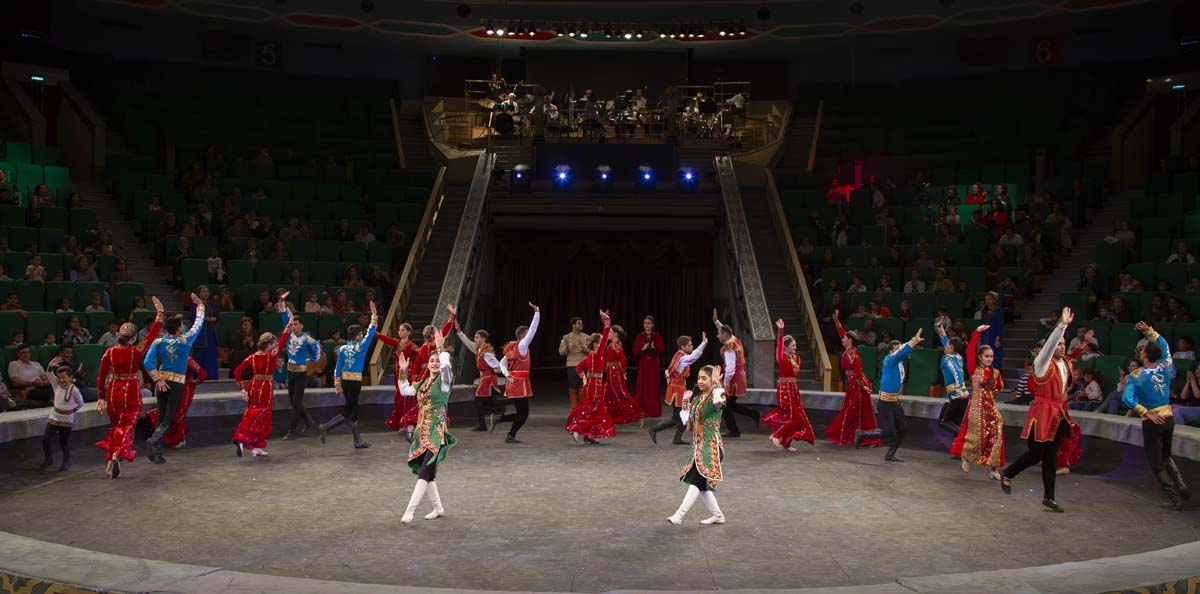The State Museum of the State Cultural Centre has opened updated and expaneded exposition hall dedicated to the history and culture of the Middle Ages.

The first visitors had been acquainted with the museum treasures, many of which earlier was stored at closed funds and now take their rightful place in the showcases and stands.

The exposition is arranged in chronological order. Opening section is devoted to first world religions, namely Zoroastrianism, which is according to scientist originated from the Turkmen land. Fire temples was discovered by archaeologists in Babadurmaz, Ahal province, at Akdepe hill near the village of Artyk and Meleheyran area in Serahs oasis. Interesting findings, indicating on the cult of worshipers and funerary rites, as described in their holy book of Avesta, was reveled in Balkan, Dashoguz and Mary provinces. The most interesting materials of the first centuries of the new era take roots from the banks of the Amu Darya, which was part of the Kushan Empire.

The next section consists of significant artifacts testifying on spreading of Nestorian Christianity in early medieval Merv. During the epoch of the Roman Empire and then the Byzantine Empire the followers of this religion were persecuted and were forced to move far at easrtern direction, namely to Merv, where they found a safe refuge and settled for several centuries. Simultaneously with the Christians, this ancient metropolis became the home for large community of Buddhists. The luxurious inside-painted ceramic vase, used to keep the Buddhist scroll of the VI century, is among the surprising findings proving above mentioned historical fact. The diorama with the reconstruction of the complex gives the idea about appearance of the Buddhist temple with the huge clay statue of Buddha, discovered half a century ago in ancient Merv.

The culture of the Turkmen-Oguz had been showcased at the new exhibition as well. One of the major exhibits of this section is the stone statue-balbal, recently demonstrated at the Metropolitan Museum, in New York.

The historical period of formation of the Arab Caliphate in VII century and adoption of Islam by Turkmen people had been comprehensively displayed as well. In that period two super powers - Great Seljuk and Khorezmshahs appeared. Their blossoming time in XI-XII centuries was marked by the rapid cultural development, as evidenced from the exhibits. Among them are the fragments of architectural decoration of mosques and mausoleums, metal and bronze tableware with artistic stamping and etching, stamped and glazed ceramics with delicate ornaments, copper, silver and gold coins, jewelry made of precious metals, as well as much more.



The first visitors had been acquainted with the museum treasures, many of which earlier was stored at closed funds and now take their rightful place in the showcases and stands.

The exposition is arranged in chronological order. Opening section is devoted to first world religions, namely Zoroastrianism, which is according to scientist originated from the Turkmen land. Fire temples was discovered by archaeologists in Babadurmaz, Ahal province, at Akdepe hill near the village of Artyk and Meleheyran area in Serahs oasis. Interesting findings, indicating on the cult of worshipers and funerary rites, as described in their holy book of Avesta, was reveled in Balkan, Dashoguz and Mary provinces. The most interesting materials of the first centuries of the new era take roots from the banks of the Amu Darya, which was part of the Kushan Empire.

The next section consists of significant artifacts testifying on spreading of Nestorian Christianity in early medieval Merv. During the epoch of the Roman Empire and then the Byzantine Empire the followers of this religion were persecuted and were forced to move far at easrtern direction, namely to Merv, where they found a safe refuge and settled for several centuries. Simultaneously with the Christians, this ancient metropolis became the home for large community of Buddhists. The luxurious inside-painted ceramic vase, used to keep the Buddhist scroll of the VI century, is among the surprising findings proving above mentioned historical fact. The diorama with the reconstruction of the complex gives the idea about appearance of the Buddhist temple with the huge clay statue of Buddha, discovered half a century ago in ancient Merv.

The culture of the Turkmen-Oguz had been showcased at the new exhibition as well. One of the major exhibits of this section is the stone statue-balbal, recently demonstrated at the Metropolitan Museum, in New York.

The historical period of formation of the Arab Caliphate in VII century and adoption of Islam by Turkmen people had been comprehensively displayed as well. In that period two super powers - Great Seljuk and Khorezmshahs appeared. Their blossoming time in XI-XII centuries was marked by the rapid cultural development, as evidenced from the exhibits. Among them are the fragments of architectural decoration of mosques and mausoleums, metal and bronze tableware with artistic stamping and etching, stamped and glazed ceramics with delicate ornaments, copper, silver and gold coins, jewelry made of precious metals, as well as much more.








